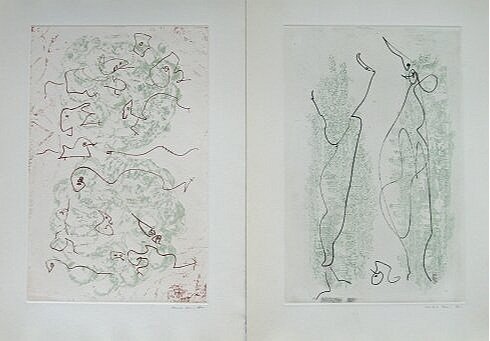
German-born painter, sculptor and printmaker; one of the leading Surrealists, Ernst was a primary pioneer of the Dada movement. The paintings of de Chirico helped to stimulate his interest in dream-like fantastic imagery, and he founded the Cologne Dada group with Baargeld and Arp 1919-21.
(1891-1976)
Max Ernst.
A key member of first Dada and then Surrealism in Europe in the 1910s and 1920s, Max Ernst used a variety of mediums - painting, collage, printmaking, sculpture, and various unconventional drawing methods—to give visual form to both personal memory and collective myth. By combining illusionistic technique with a cut-and-paste logic, he made the incredible believable, expressing disjunctions of the mind and shocks of societal upheavals with unsettling clarity.
After serving for four years in World War I, the German-born Ernst returned traumatized to Cologne (near his birthplace of Brühl) in 1918. It was there that he produced his first collages alongside fellow Dadaists Jean (Hans) Arp and Johannes Baargeld. In his works from this period, he used mechanically-reproduced fragments, such as the image of a chemical bomb being released from a military plane in the background of Here Everything is Still Floating, to reflect a world of rubble and shards.
Ernst is most closely associated with Surrealism, an artistic and literary movement in Paris in the 1920s that prized the irrational and the unconscious over order and reason. A key contribution to this movement was his invention of frottage, a technique of placing paper over a textured material, such as wood grain or metal mesh, and rubbing it with a pencil or crayon to achieve various effects. The Surrealists prized this practice—which produced compositions like Forest and Sun—for both the serendipity of the resulting imagery and the passivity it encouraged, bypassing the constraints of the artist’s rational mind. Having little control over the resulting patterns, Ernst marveled that he “came to assist as spectator at the birth of all my works.”1 Eventually, he translated the method from paper to painting, using the word grattage to describe this technique of scraping wet paint off of the canvas to achieve similar patterned effects.
The fragmented logic of collage, which Ernst referred to as “the culture of systematic displacement,” persists in his paintings, whose subjects are disjointed even if their surfaces are smooth. In these foreboding dreamscapes, headless bodies and body-less hands appear incongruously amid lush forests or on deserted beaches. In the years leading up to World War II, and during his time as an émigré to the United States from 1941 to 1953, Ernst made work that once again reflected the menacing atmosphere of war.
Samantha Friedman, Assistant Curator, Department of Drawings and Prints, 2016
Notable Exhibitions:
Venice Biennale, Venice (1954), received Grand Prize for Painting
Musée National d'Art Moderne Paris (1959), awarded the Grand Prix national des arts
Museum of Modern Art, New York (1961)
Tate Gallery, London (1962)
Kunsthaus Zürich (1963)
Moderna Museet, Stockholm (1969)
A retrospective of 104 works spanning the years 1920–1968, drawn entirely from the Menil Collection, toured Europe from 1970 to 1972
In 2005, "Max Ernst: A Retrospective" opened at the Metropolitan Museum of Art

